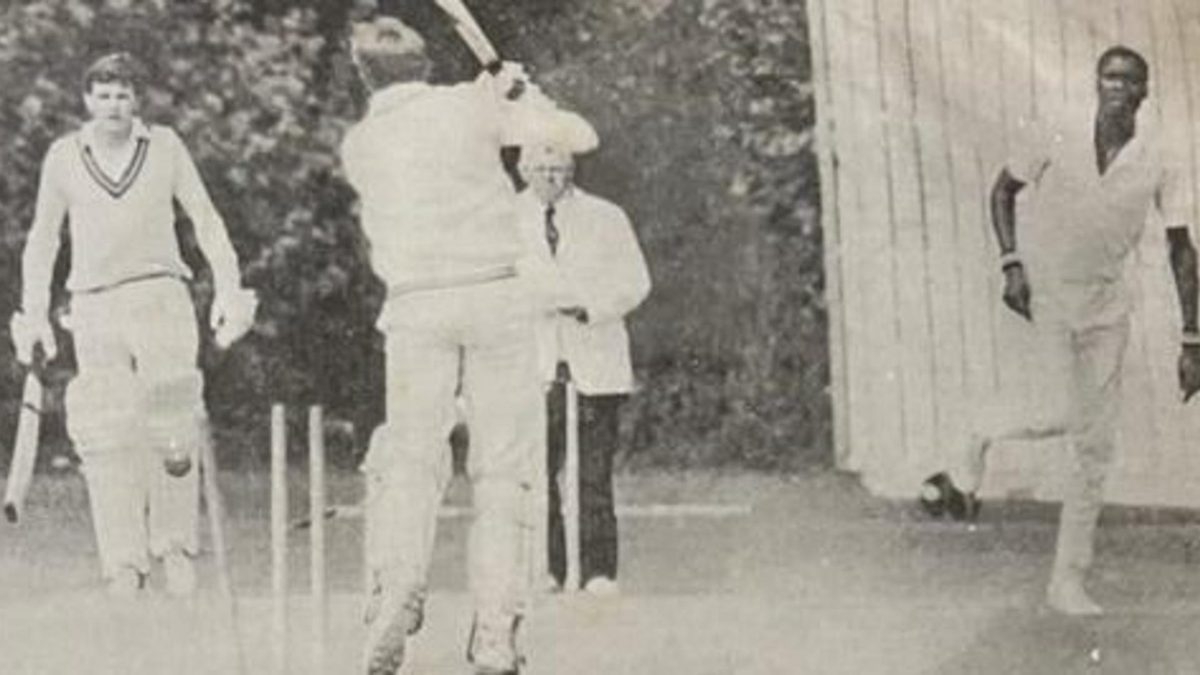
In the mid-to-late Eighties, before his West Indies Test debut and with one first-class appearance to his name, Curtly Ambrose cut his teeth playing club cricket in Lancashire. In a two-part series, Scott Oliver speaks to those who played with and against him as he wreaked havoc, first for Chester Boughton Hall CC and then for Heywood. Part one is available to read here.
Brought to you in association with NatWest, Wisden’s Club Cricket Partner, supporting cricket at all levels for almost 40 years and a proud partner of the ECB and Chance to Shine. NatWest CricketForce helps local cricket clubs to make more from their money through free online advice and toolkits.
Follow @NatWest_Cricket and #NoBoundaries on Twitter to find out more
Read more club cricket stories
The Central Lancashire League (CLL) had a long history of stellar West Indian pros – Garry Sobers and Frank Worrell at Radcliffe, Rohan Kanhai and Sonny Ramadhin at Crompton, Colin Croft, Larry Gomes, Learie Constantine, the ferocious Roy Gilchrist at Middleton – and Curtly Ambrose would find a clutch of familiar Caribbean faces throughout the opposition ranks of this storied competition, bunched tightly around the northern and eastern fringes of Greater Manchester.
Ten of the 16 clubs had West Indian pros in 1987 (unlike the Liverpool and District Cricket Competition, the CLL saw a full home-and-away programme of 48-over matches, 30 fixtures requiring several Sunday and bank holiday appointments), which included the likes of Vanburn Holder, leg-spinning Jamaican all-rounder Robert Haynes, Joel Garner, Ezra Moseley and two of Ambrose’s fellow Test tourists the following summer, Gus Logie and Carl Hooper.
After the traditional pre-season friendly at Colne had been snowed off, first up for Heywood was the visit of Rochdale, who had the former Barbados, Worcestershire and West Indian ‘Rebel’ quick Hartley Alleyne as stand-in pro. They made a good start, too, adding 87 for the first wicket and reaching 107-1 in the 34th over, with Ambrose’s figures, either side of a change of ends, an underwhelming 0-44 off 14. Some of the longer-toothed, I’ve-seen-‘em-all sages of northern club cricket crowds have been known to reach their final verdict by that stage.
“I asked him what field he wanted,” recalls his skipper, David Fare, then a veteran 38-year-old left-arm spinner. “He said: ‘You de captain, man. You set de field’. He was a man of few words, was Curtly.” Indeed he was, and he was also prone to use those few words to talk about how he was a man of few words, usually while referring to himself in the third person. Thus the famous follow-up to a reporter who he’d advised to “ask Curtly if you want to know about Curtly”: “Curtly talk to no man”.
[caption id=”attachment_168098″ align=”alignnone” width=”800″]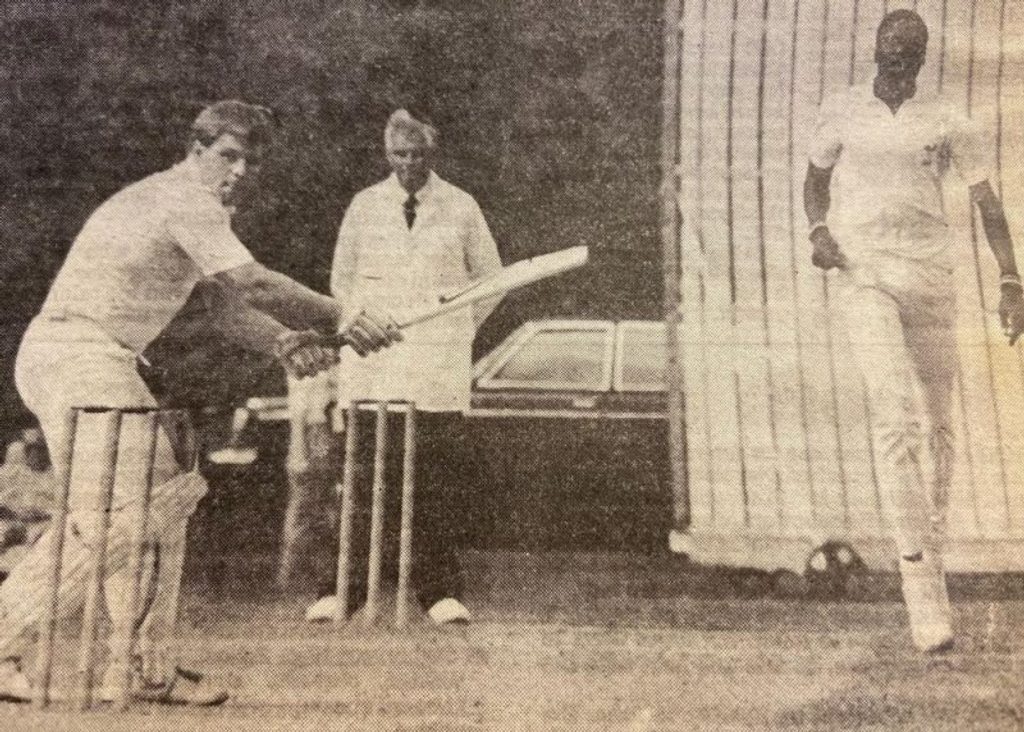 Curtly Ambrose in action for Heywood Cricket Club[/caption]
Curtly Ambrose in action for Heywood Cricket Club[/caption]
Similarly, when Curtly was minded to communicate with Fare, he referred to him not by name, or even by his nickname, ‘Shag’, says Colin Wroe, Heywood’s diminutive opening batsman and short leg fielder. “He always called him ‘the Heywood captain’. Even in the bar. ‘Ask the Heywood captain’. Or: ‘Heywood captain, what number am I batting?’ And we didn’t know him as ‘Ambi’, either. He called himself ‘CB’, which stood for ‘Curtly Bouncer’.”
The verbal minimalism only added to his on-field aura, notes the Heywood captain, chiming with an observation made by Steve Waugh about the man he considered his toughest adversary. “He always made a big thing of going down to the batsman’s end before he’d bowled a ball,” says Fare, “basically to look at where he wanted to pitch it. Which was fair enough, and he said as much to Wardy [Ian Ward] in an interview on Sky Sports. What he didn’t say was that it was also about intimidation. As well as looking at the pitch, he also had a bit of a glare at the batsman. Which at our level you’d probably find quite worrying.”
[breakout id=”0″][/breakout]
Not that it was working too well on debut. But after having his end switched by the Heywood captain, Ambrose sent down a spell of 7.2-3-10-8, finishing with 8-54 as Rochdale were hustled out for 131, which were duly knocked off. Indeed, they won three and drew one of the first four games – Ambrose taking 4-67 at Crompton amid sleety conditions, 7-47 against Norden, including the wicket of Logie for 51, and 5-71 against Stockport – but it would prove something of a false dawn as they embarked on an 11-game, 71-day stretch without another league victory.
The first game of this drought exemplified the team’s issues. Ambrose chipped in with 9-42 as Littleborough were hustled out for 102, which was great until Heywood themselves slipped from 19-0 to 38 all out, with Ezra Moseley bagging 5-21 and Brian Clarke returning 13-8-15-5. It was indicative of Heywood’s batting woes. There was only one 60-plus score all season, just four half-centuries, and Curtly, despite telling ‘the Heywood captain’ he was “a number three or four”, only twice reached 20. (“Curtly had his big pads, but no other gear.” recalls Wroe. “He didn’t bat in a thigh pad. He had his big bat with five grips and I think he thought he was Clive Lloyd. But it took about one match – a couple of those big lunges – for ‘Shag’ to realise he wasn’t a number three”.)
[caption id=”attachment_168103″ align=”alignnone” width=”616″]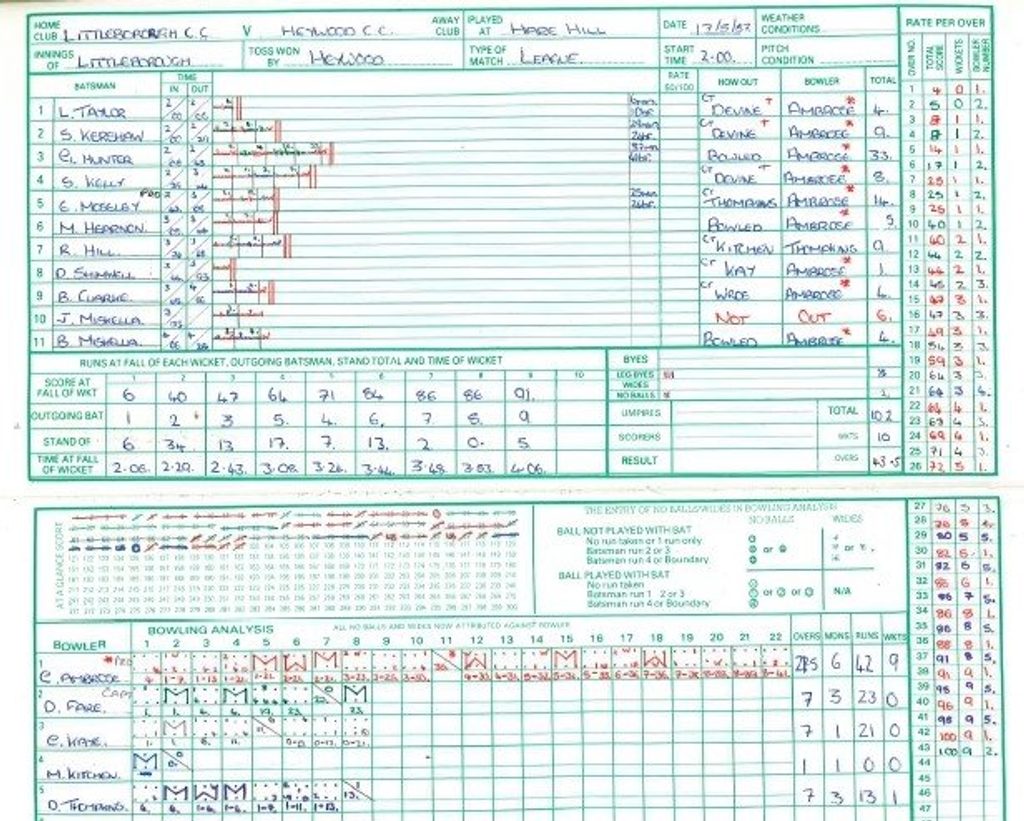 The evidence of Curtly Ambrose’s carnage at Littlewood[/caption]
The evidence of Curtly Ambrose’s carnage at Littlewood[/caption]
One of these batting bounties came in the next game, against Ashton. Chasing the visitors’ total of 168, Heywood had reached 167-8, with Ambrose on 45 not out and at the non-striker’s end, when Ashton skipper Dave Mellor clean bowled number 10, Vinny Ball, then had number 11, Bob Yardley, son of former England skipper Norman Yardley, caught behind without scoring. Mellor had career-best figures of 8-43 as Ashton complete a one-run heist, with Curtly bewildered and helpless. “He didn’t say anything,” observes Mellor, “but then the only time he spoke on the field was when he appealed.”
The day after the Ashton nailbiter, Dipak Patel – who made his Test debut for New Zealand that year batting at number five, yet ended up as low as number ten – stroked a chanceless, untroubled 103 as sub pro for Royton. A fortnight later, bookending a run of four draws, Castleton Moor opener John Stapleton, a dustman and semi-pro rugby league player with Rochdale and Swinton, made the same score: 103 out of 176-7. “He hit me flush on the arm second or third ball,” he says, “which hurt a lot, but I just got stuck in”.
Despite still only having a single first-class appearance to his name, Ambrose was evidently a high-grade operator, although some deathly slow pitches and marathon spells meant he was rarely at full tilt (he sent down a whopping 525.2 overs in total; if he had never come off or switched ends, the maximum possible amount it could have been was 551.3). Besides, says Wroe, the league’s history of big-name and/or slippery pros meant local batsmen weren’t necessarily spooked, even by the steepling trajectory of Ambrose. “I could be fitting a clutch at work in the morning, then facing Joel Garner in the afternoon,” he says, which indeed he was on the final day of May, with the visit of Oldham.
‘Big Bird’ had had three seasons at Littleborough in the late-70s and was now back in the CLL having been sacked by Somerset (as had Vivian Richards, of course, who was playing 25 miles north, at Rishton of the Lancashire League). In the end, Garner’s showdown with the man who would fill the tall-and-parsimonious niche in the West Indies team that he had vacated in March that year failed to catch fire.
Ambrose took 3-64 as the visitors made 225-8, which was always going to prove a stiff ask (especially given that the 167 against Ashton would be their highest total of the season), even though Garner was only able to bowl a single spell of 8-4-7-1. The Bajan would go on to top the CLL averages, with 90 wickets at 9.59 (which included two 9-37s, an 8-14 and an 8-15), just pipping Ezra Moseley, whose 119 wickets cost him 9.84.
[caption id=”attachment_168102″ align=”alignnone” width=”800″]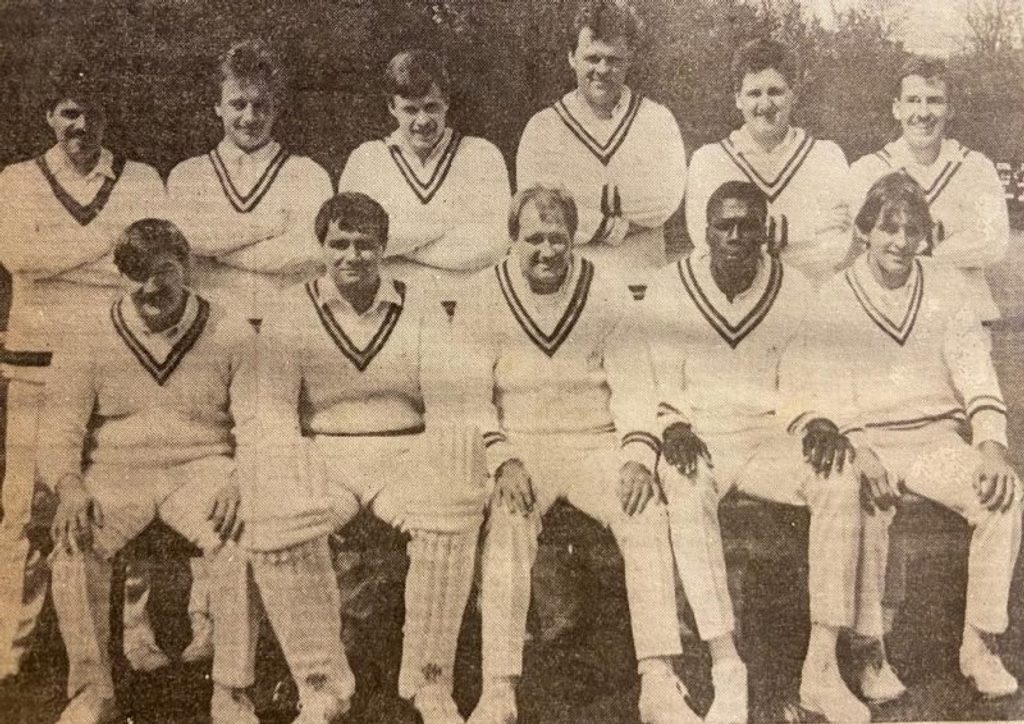 Heywood CC, 1987. Colin Wroe, front left. David Fare, front centre[/caption]
Heywood CC, 1987. Colin Wroe, front left. David Fare, front centre[/caption]
The eleventh round of matches saw a face-off with Curtly’s flatmate, George Codrington, who was pro at Walsden, having followed his mate over to the Pennines. Ambrose’s package, recalls Heywood committee member and nephew of the president, Bobby Cross, was “£2500 plus air fare and accommodation, about £4000 all in” (over £11k in today’s money). But he still had no driver’s licence, so would catch the bus down through Rochdale to Heywood or the train into Manchester Victoria before connecting over to Chester, where he often passed his weekdays staying with Jenson Joseph, fellow Antiguan and that year’s Viv Richards scholar. And it was down to Wroe and Yardley to ferry the pro back home to Walsden after matches.
“We usually stopped off for KFC,” Wroe recalls. “But he’d always say: ‘No wings, man!’ He used to come and have tea with me and the wife, too, then I’d take him home, or to Rochdale to get the bus. He’d leave his bag outside the front door. I’d say, ‘Why are you doing that?’ He said, ‘Well who’s going to pinch it?’ Life was a bit different in Antigua.”
[breakout id=”1″][/breakout]
The Walsden game saw Heywood make it eleven straight league games bowling first, Codrington top-scoring with 31 on a damp day as Ambrose’s relatively expensive figures of 5-61 helped dismiss their hosts for 97. In reply, Heywood nudged to 63-3 and 83-5 before a remarkable spell of 9-7-6-5 from Chris Barker bundled them out for 85. Calamitous it may have been, but at least Ambrose didn’t need a lift home.
The following weekend, he took 6-71 and 7-47 in two defeats – Middleton’s Trinidadian pro Kelvin Williams making 99* out of 162-7 in the first, Heywood 55 all out chasing 145 in the second – before the final Saturday in June saw a trip to Werneth, one of the smaller grounds, and a toe-to-toe with Carl Hooper.
The game started two hours late, and was reduced to 29 overs. It was a no-contest, the Guyanese smashing eight sixes and five fours in a 62-ball hundred as Ambrose travelled to the tune of 15-0-91-0. “Carl just kept depositing Curtly into the school yard over the leg-side boundary,” observes Fare of a man who once took off his thigh pad against Lancashire at Old Trafford because his gloves were catching on it when dealing with Wasim Akram’s nip-backers. He made 166 not out. Big boy cricket, and the ball wasn’t the only thing that went to school.
[caption id=”attachment_168101″ align=”alignnone” width=”566″]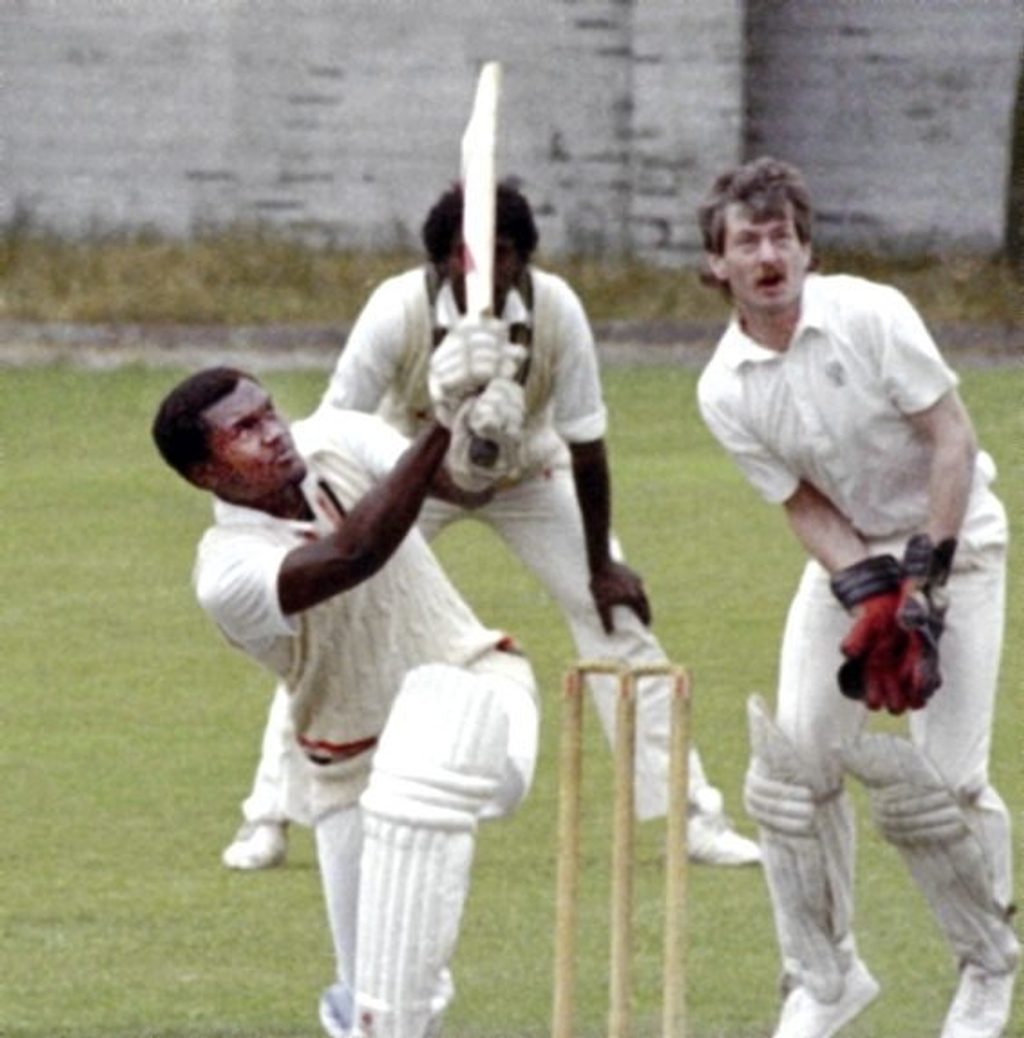 Carl Hooper hits out at Werneth (Credit: Oldham Chronicle)[/caption]
Carl Hooper hits out at Werneth (Credit: Oldham Chronicle)[/caption]
Chastened he may have been, but figures of 4-54 against Hyde gave Ambrose 74 league wickets at halfway. However, the second half of the season saw only nine games, with inclement Pennine weather forcing six cancellations, denying Ambrose the chance to do something very special.
As it happened, those two most recent outings were the first of a six-game streak without a five-for during which Ambrose’s best figures were 4-42 against Littleborough, although Ezra Moseley had earlier bagged 7-40. After that, in among the late-August monsoons, ‘CB’ picked up 6-55, 4-56 and 6-58, and was then invited down to trial at Northamptonshire in the week prior to their NatWest Trophy final against Nottinghamshire (started on a drizzly Saturday and finished on a Monday, with a Sunday League game in between). Geoff Moss, the man who brought Curtly over the previous year for his stint at Chester Boughton Hall, takes up the story:
“He was over in Chester visiting Jenson Joseph when I get a call from Steve Coverdale at Northants. He said, ‘We’re very interested in Ambrose’ and invited him down to bowl a few overs so they could have a look at him. A bit of a trial. I called Curtly and said, ‘Good news: Northants are interested. Come down to the office’. He said ‘I’m busy, man’. I said, ‘What’s wrong with you? Do you want to be a cricketer or not?’ He said, ‘I’m busy, man’, which meant he had a girl round there.
[caption id=”attachment_168096″ align=”alignnone” width=”800″]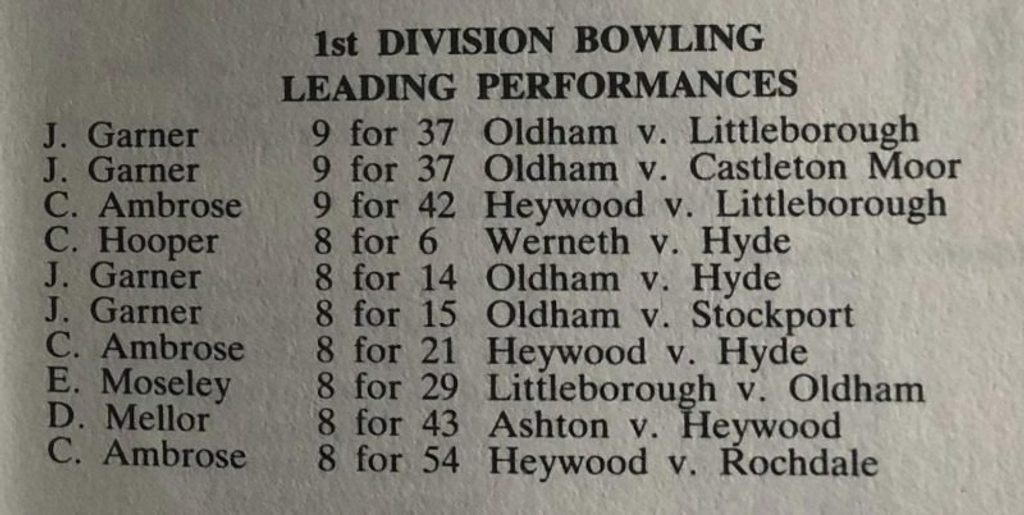 Joel Garner, Curtly Ambrose, and Carl Hooper accounted for the eight best sets of figures for the season[/caption]
Joel Garner, Curtly Ambrose, and Carl Hooper accounted for the eight best sets of figures for the season[/caption]
“Anyway, he came over and I told him Northants were going to offer him £4,000 a year, which wasn’t a lot, and he said, ‘I don’t know’. I said, ‘I’m going out of the room for five minutes and when I get back you can tell me whether you want to be a cricketer or not’. He said he’d go, then I said he had to go smart: ‘We’ll go to Marks & Spencer and get you a shirt, tie and jacket’. He says, ‘No, I’m not doing that’. After a bit of negotiation, we settled on a sweater rather than a jacket, with a shirt and tie, and that’s how he went.
“He missed the train, but eventually got there. Next day, Steve Coverdale rings me up and says, ‘Oh my God, he nearly knocked Allan Lamb’s head off. We had to tell him to calm down because we had the NatWest final the next day’. They offered him just short of £4,000, sent the contract to me, but by that stage he’d gone back to Antigua.”
Back in Lancashire, the cancelled games meant no return encounters with Hooper or Logie – whose 1342 runs at 63.90 for champions Norden were top on both accounts – but the feelgood vibes of the Northants trial fed directly into a devastating spell of 16-8-21-8 at Hyde in what turned out to be his penultimate outing in English league cricket – his final gallop at Heywood’s Crimble ground.
If Hyde was the best of Ambrose, his last appearance in English club cricket was more Dr Jekyll. Perhaps feeling demob happy – it was the day before his 24th birthday, too – he was carted all round neighbours Rochdale by Robert Haynes, who made 71 in a chase of 109 as Ambrose disappeared for 8-0-51-0. It wasn’t the ideal way to sign off, and Heywood had finished a disappointing 11th, but Ambrose’s 109 league wickets at 12.48 (higher than his batting average, denying him his coveted all-rounder status) were a formidable return. Aged 24, with an enormous volume of overs under his belt, his star was in the ascendant. He was ready to add to that solitary first-class appearance.
[caption id=”attachment_168104″ align=”alignnone” width=”800″]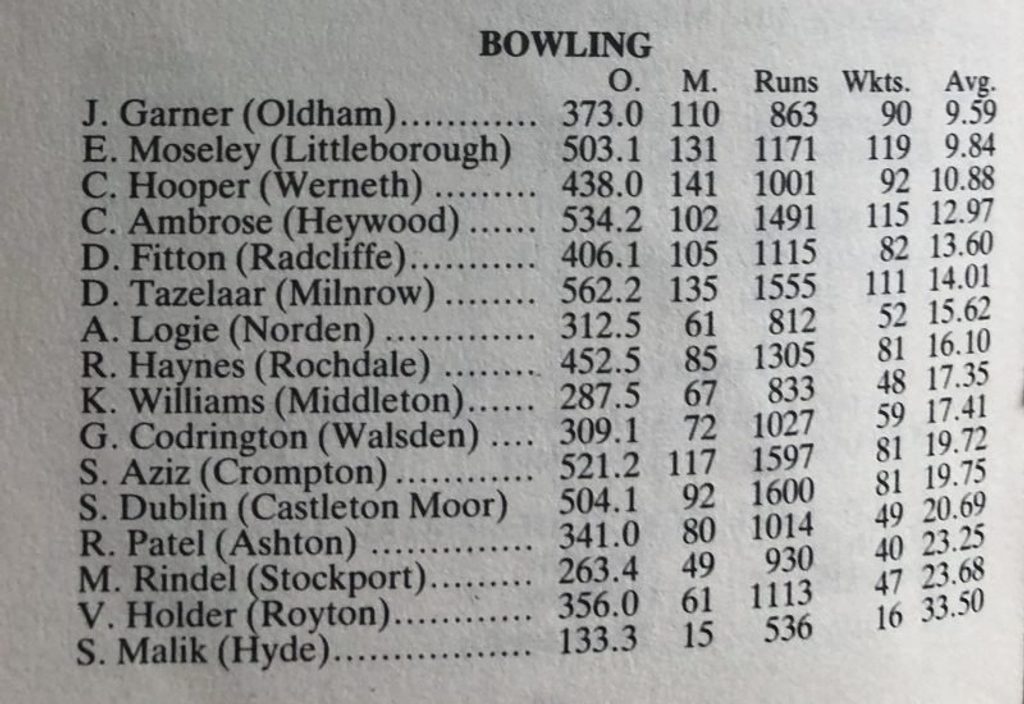 The season’s bowling averages[/caption]
The season’s bowling averages[/caption]
“At the end of November,” recalls Moss, “Coverdale rang me saying Curtly hadn’t sent the contract back yet. By the end of February, he’d broken the Red Stripe Cup record for most wickets, but still hadn’t sent the contract through. Steve rang again to say he was doubling the money, at which point Curtly signed it and sent it over”.
By April, he was debuting against Pakistan, and by June he was touring England, where colleagues from both clubs caught up with their former destroyer at the Old Trafford Test. Ambrose brought the West Indies squad down to Boughton Hall for a social game, with Desmond captaining and Viv looking on, but by that stage the 22-year-old who’d turned up on a scholarship, slipping and sliding like Bambi through his opening spell on English soil, had turned into the real-deal terminator, albeit still one with whom communication could be challenging, as Colin Wroe discovered.
“After he left, I caught up with him at one of the Tests and told him I was going to write him a letter and asked for an address. He said, ‘Send it to “Curtly Ambrose, Swetes Village, Antigua”. It will find me’.”








